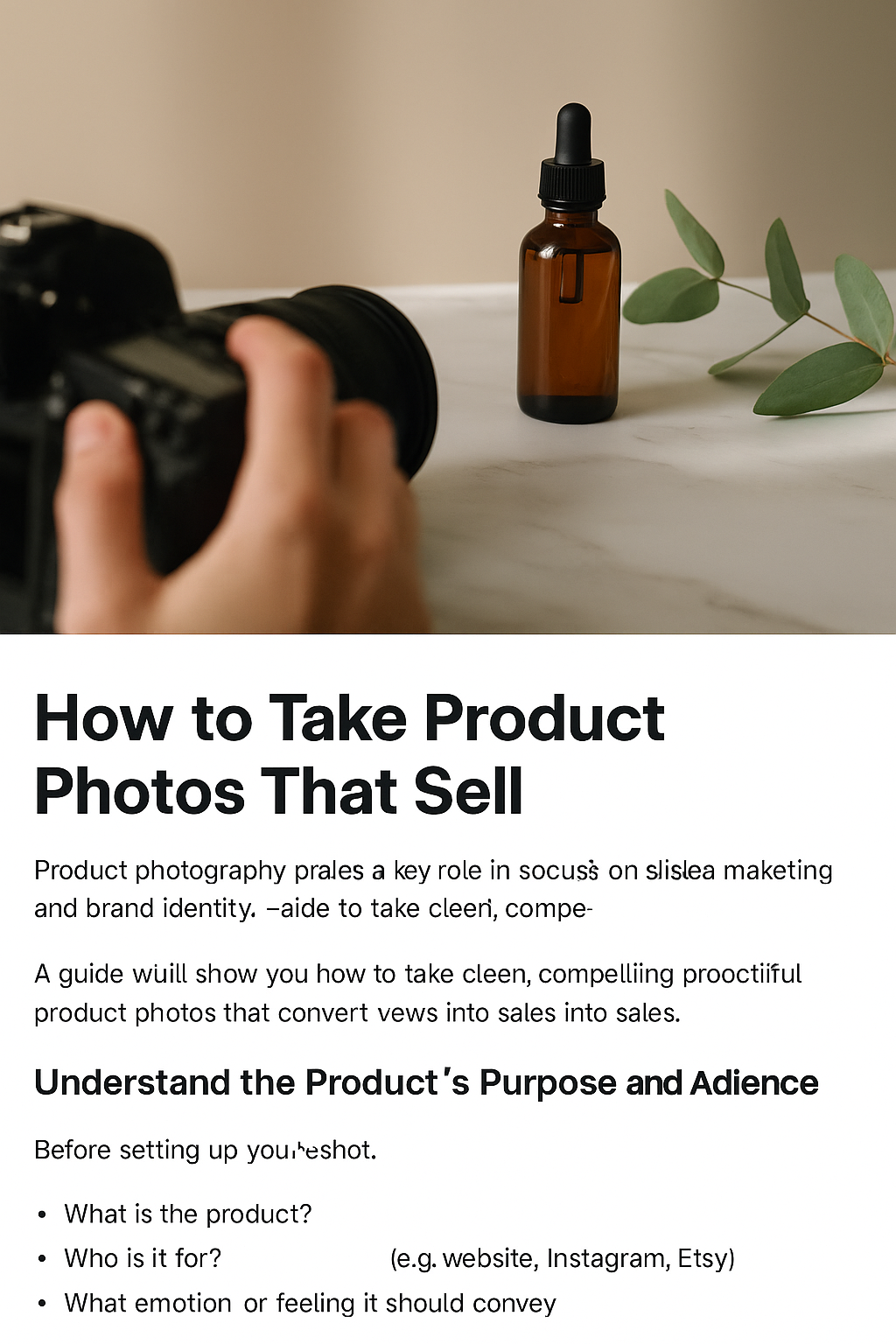Product photography plays a key role in the success of online shops, social media marketing, and brand identity. A well-taken product photo doesn’t just show what something looks like—it makes the viewer want it.
Whether you’re working with your own products, helping a local business, or building a portfolio, this guide will show you how to take clean, compelling product photos that convert views into sales.
Understand the Product’s Purpose and Audience
Before setting up your shoot, ask yourself:
What is the product?
Who is it for?
Where will the photo be used (e.g., website, Instagram, Etsy)?
What emotion or feeling should it convey?
For example, a handmade candle should feel warm and cozy, while a tech gadget should look modern and sleek. Understanding the audience helps you style and light the photo correctly.
Choose the Right Background
Your background should highlight the product—not compete with it.
Use a white or light gray background for e-commerce (Amazon, Shopify, etc.)
Use lifestyle backgrounds (tables, counters, shelves) for social media and branding
Use solid colors or subtle textures to complement the product’s color
If possible, shoot with some distance between your product and the background to create soft depth.
You can buy inexpensive backdrops online or make your own with poster board or wood panels.
Use Natural Light or Soft Artificial Light
Light is everything in product photography. It defines shape, texture, and clarity.
For beginners, natural window light is perfect:
Shoot next to a window with indirect light (not harsh sunlight)
Use white foam board or reflectors to bounce light and reduce shadows
Use a curtain or diffuser to soften strong light
If using artificial lights:
Use LED softboxes or continuous lights
Avoid on-camera flash—it creates hard shadows
Always aim for even, shadow-free lighting unless going for a dramatic look
Position the light at a 45-degree angle to your product for natural dimension.
Use a Tripod for Stability
Product photography often requires precision. A tripod helps you:
Keep your composition consistent
Avoid blur from camera shake
Shoot in low light without increasing ISO
Use a remote shutter or self-timer to further reduce movement.
Even a small phone tripod with a ring light can significantly improve your results.
Focus on the Product’s Key Features
When photographing products, think like the buyer. What details would you want to see?
Take shots that show:
The full product
Close-ups of texture, material, or fine details
Different angles (front, side, back, top)
Size comparisons (with a hand, coin, etc.)
Packaging and branding if relevant
This variety helps build trust and gives the customer a complete understanding of the product.
Keep Composition Clean and Balanced
Center the product for a clean e-commerce shot
Use negative space to avoid a crowded look
Follow the rule of thirds for lifestyle shots
Align labels, patterns, and surfaces to show care and precision
Remove distracting elements from the frame and watch for dust, fingerprints, or reflections.
Edit for a Polished Look
Even great product photos benefit from editing. Use tools like Lightroom, Snapseed, or Photoshop to:
Adjust exposure and contrast
Correct white balance (especially for product color accuracy)
Sharpen edges and remove noise
Clean background imperfections (dust, scratches, etc.)
Avoid over-editing. Your product should look realistic and true to color, especially if customers will receive it in person.
Style the Shot for Context (Optional)
For social media or marketing content, you can create styled product photos that show the item in use or in a themed environment.
Use props that match the brand’s vibe
Keep the focus on the product—not the setting
Add hands using the product (adds a human element)
Lifestyle shots help customers imagine the product in their own life, increasing emotional connection and likelihood to buy.
Shoot in Batches
Once your setup is ready, photograph several products or variations in one session. This saves time and keeps the lighting and editing style consistent.
Create a shot list beforehand:
Main photo
Detail shot
Angle shots
Lifestyle version (if applicable)
Consistency across your product images helps build brand trust and looks more professional in a store or catalog.
Save in the Right Format
Export images in high resolution for print or website use
Use JPEGs for most platforms, PNG if you need a transparent background
Keep image sizes optimized to avoid slow website loading (under 1 MB is ideal)
Name files clearly for SEO and organization (e.g., red-wool-scarf-front.jpg)
You Don’t Need Fancy Gear to Start
You can take amazing product photos with just a smartphone, natural light, and some creativity. What matters most is your attention to detail, lighting, and presentation.
Over time, you can upgrade your gear—but focus on mastering technique first.
Start with one product. Try different angles, lighting setups, and edits. Observe what works best and repeat. The more you shoot, the more confident and professional your photos will become.
